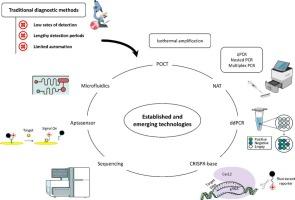传染病分子诊断。
IF 2.9
3区 医学
Q2 MEDICAL LABORATORY TECHNOLOGY
引用次数: 0
摘要
分子诊断方法已用于临床和环境设置超过三十年。传统方法通常涉及较长的处理时间和有限的灵敏度,正逐渐被提供改进分析性能的分子测试所取代。核酸检测(NAT),特别是基于PCR的方法及其变体,如定量PCR (qPCR)和反转录PCR (RT-PCR),已经证明比传统的检测方法具有更高的灵敏度和特异性。新一代测序(NGS)的最新发展,包括宏基因组和全基因组测序,也加强了对复杂病原体和耐药机制的鉴定。即时检测(POCT)是另一项进步,它得到了新开发的等温扩增(IA)技术的支持,如环介导等温扩增(LAMP)和重组酶聚合酶扩增(RPA),这些技术可以在分散的环境中进行快速检测。此外,新的方法,如液滴数字PCR (ddPCR)和基于crispr的诊断是非常有前途的,因为它们有可能在低量的靶标中提供准确的核酸检测。基于适配体的传感器在感染诊断中的应用也在广泛的研究和开发中。本文综述了传统和最新的先进分子诊断工具,重点介绍了它们在传染病检测中的应用。本文章由计算机程序翻译,如有差异,请以英文原文为准。

Molecular diagnostics for infectious disease
Molecular diagnostic methods have been used in clinical and environmental settings for over three decades. Conventional approaches, which often involve long processing times and limited sensitivity, are gradually being replaced by molecular tests that offer improved analytical performance. Nucleic acid testing (NAT), particularly PCR-based methods and their variants such as quantitative PCR (qPCR) and reverse transcription PCR (RT-PCR), have demonstrated higher sensitivity and specificity than conventional assays. Recent developments in next-generation sequencing (NGS), including metagenomic and whole-genome sequencing, have also enhanced the identification of complex pathogens and resistance mechanisms. Point-of-care testing (POCT) is another advancement, supported by newly developed isothermal amplification (IA) techniques such as loop-mediated isothermal amplification (LAMP) and recombinase polymerase amplification (RPA), which allow rapid detection in decentralized settings. In addition, newer approaches such as droplet digital PCR (ddPCR) and CRISPR-based diagnostics are very promising due to their potential to provide accurate nucleic acid detection in low amounts of target. Aptamer-based sensors are also under extensive research and development for their application in diagnosis of infection. This review outlines both traditional and recent advanced molecular diagnostic tools, with a focus on their application to infectious disease detection.
求助全文
通过发布文献求助,成功后即可免费获取论文全文。
去求助
来源期刊

Clinica Chimica Acta
医学-医学实验技术
CiteScore
10.10
自引率
2.00%
发文量
1268
审稿时长
23 days
期刊介绍:
The Official Journal of the International Federation of Clinical Chemistry and Laboratory Medicine (IFCC)
Clinica Chimica Acta is a high-quality journal which publishes original Research Communications in the field of clinical chemistry and laboratory medicine, defined as the diagnostic application of chemistry, biochemistry, immunochemistry, biochemical aspects of hematology, toxicology, and molecular biology to the study of human disease in body fluids and cells.
The objective of the journal is to publish novel information leading to a better understanding of biological mechanisms of human diseases, their prevention, diagnosis, and patient management. Reports of an applied clinical character are also welcome. Papers concerned with normal metabolic processes or with constituents of normal cells or body fluids, such as reports of experimental or clinical studies in animals, are only considered when they are clearly and directly relevant to human disease. Evaluation of commercial products have a low priority for publication, unless they are novel or represent a technological breakthrough. Studies dealing with effects of drugs and natural products and studies dealing with the redox status in various diseases are not within the journal''s scope. Development and evaluation of novel analytical methodologies where applicable to diagnostic clinical chemistry and laboratory medicine, including point-of-care testing, and topics on laboratory management and informatics will also be considered. Studies focused on emerging diagnostic technologies and (big) data analysis procedures including digitalization, mobile Health, and artificial Intelligence applied to Laboratory Medicine are also of interest.
 求助内容:
求助内容: 应助结果提醒方式:
应助结果提醒方式:


